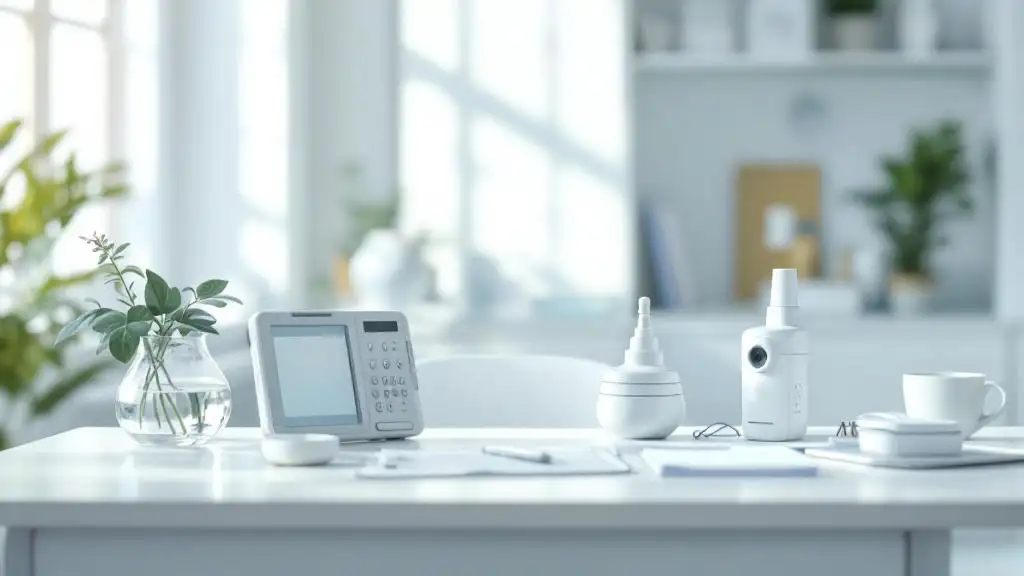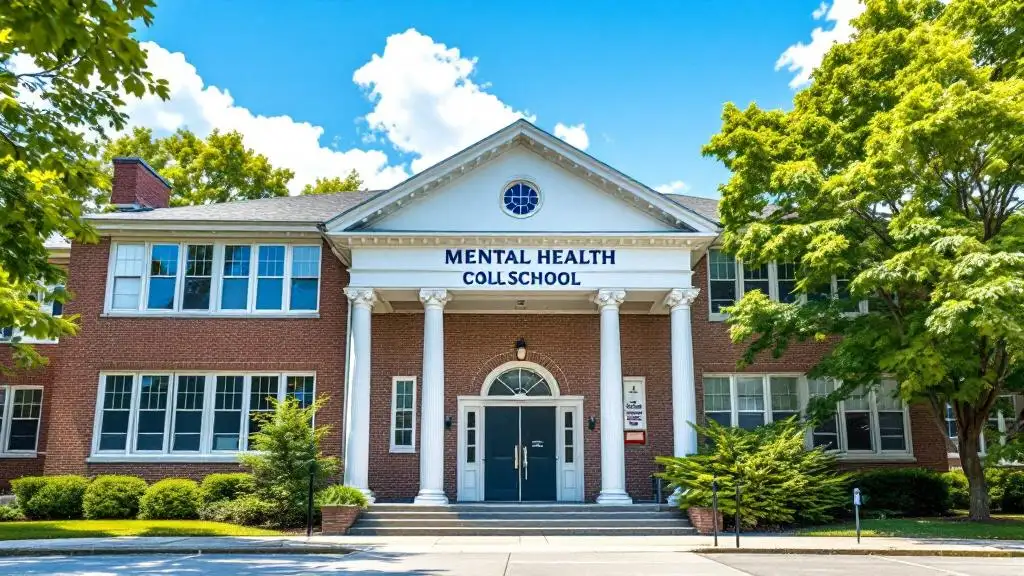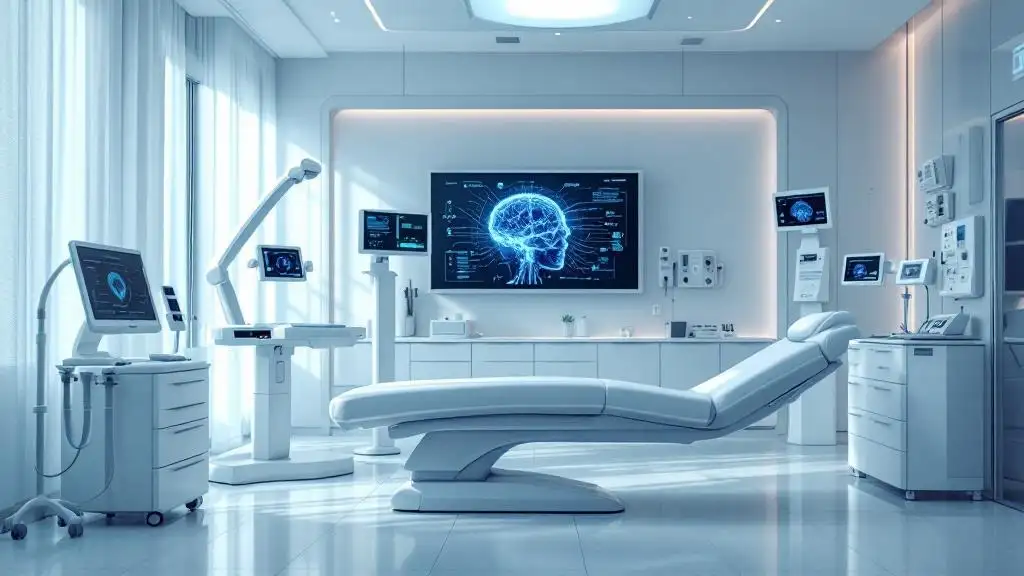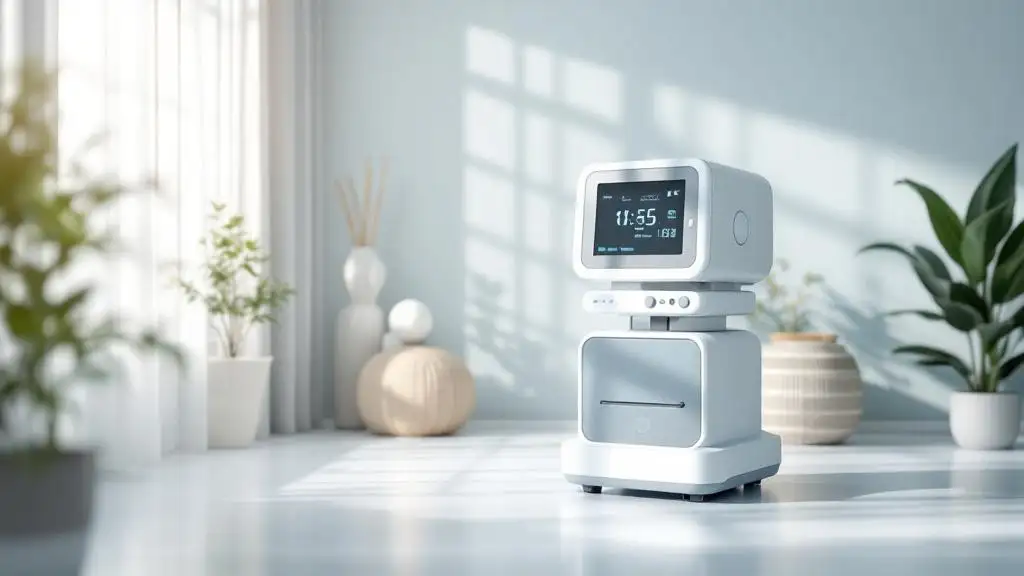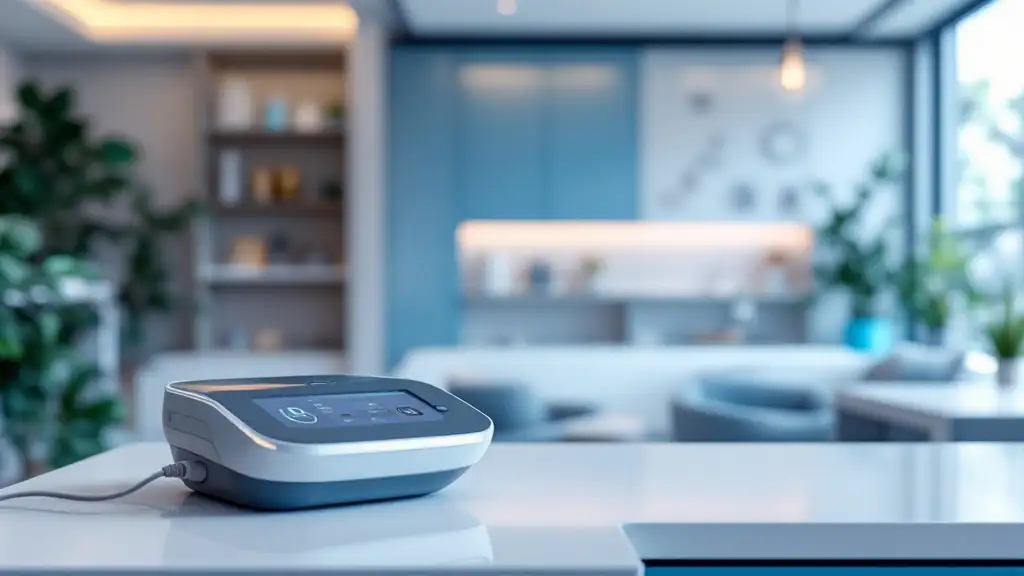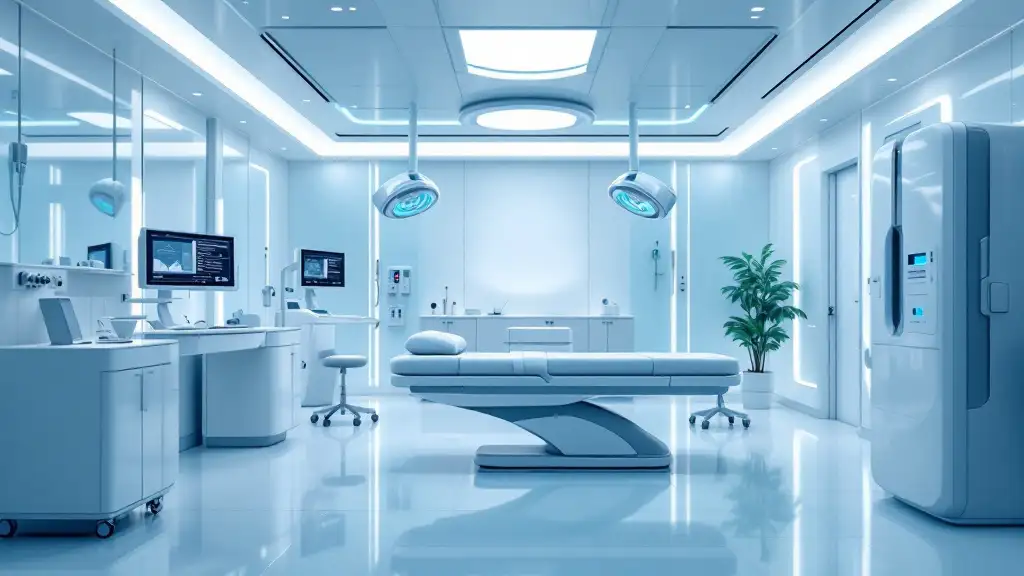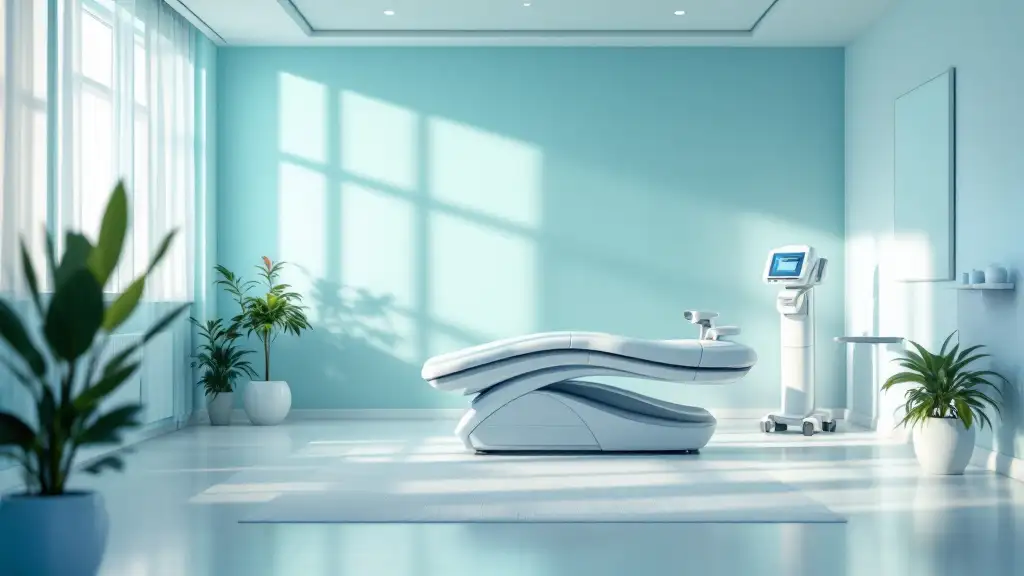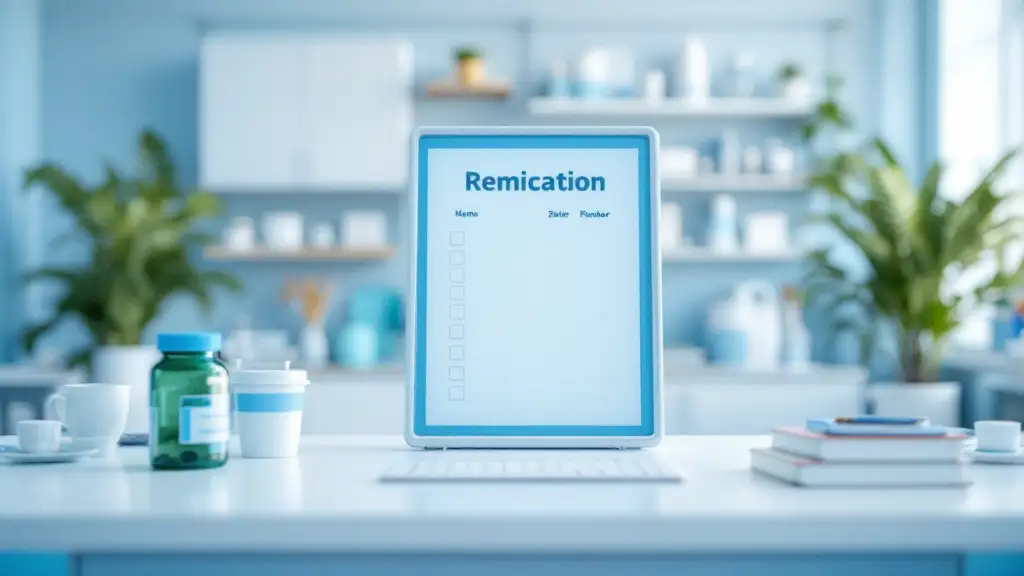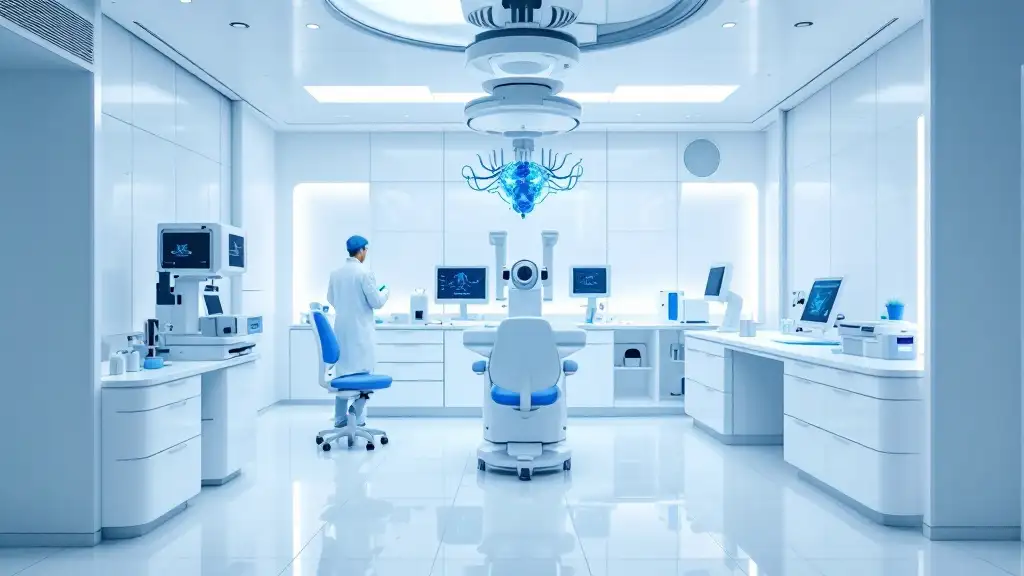Separating Fact from Fiction About TMS Therapy
Transcranial Magnetic Stimulation (TMS) has become increasingly recognized as a safe and effective treatment for depression and other mental health conditions. Despite its growing popularity and decades of research, misconceptions persist that hinder understanding and acceptance. This article aims to dispel common myths surrounding TMS therapy, providing the facts to help patients, caregivers, and healthcare providers make informed decisions.
Understanding What TMS Therapy Actually Is
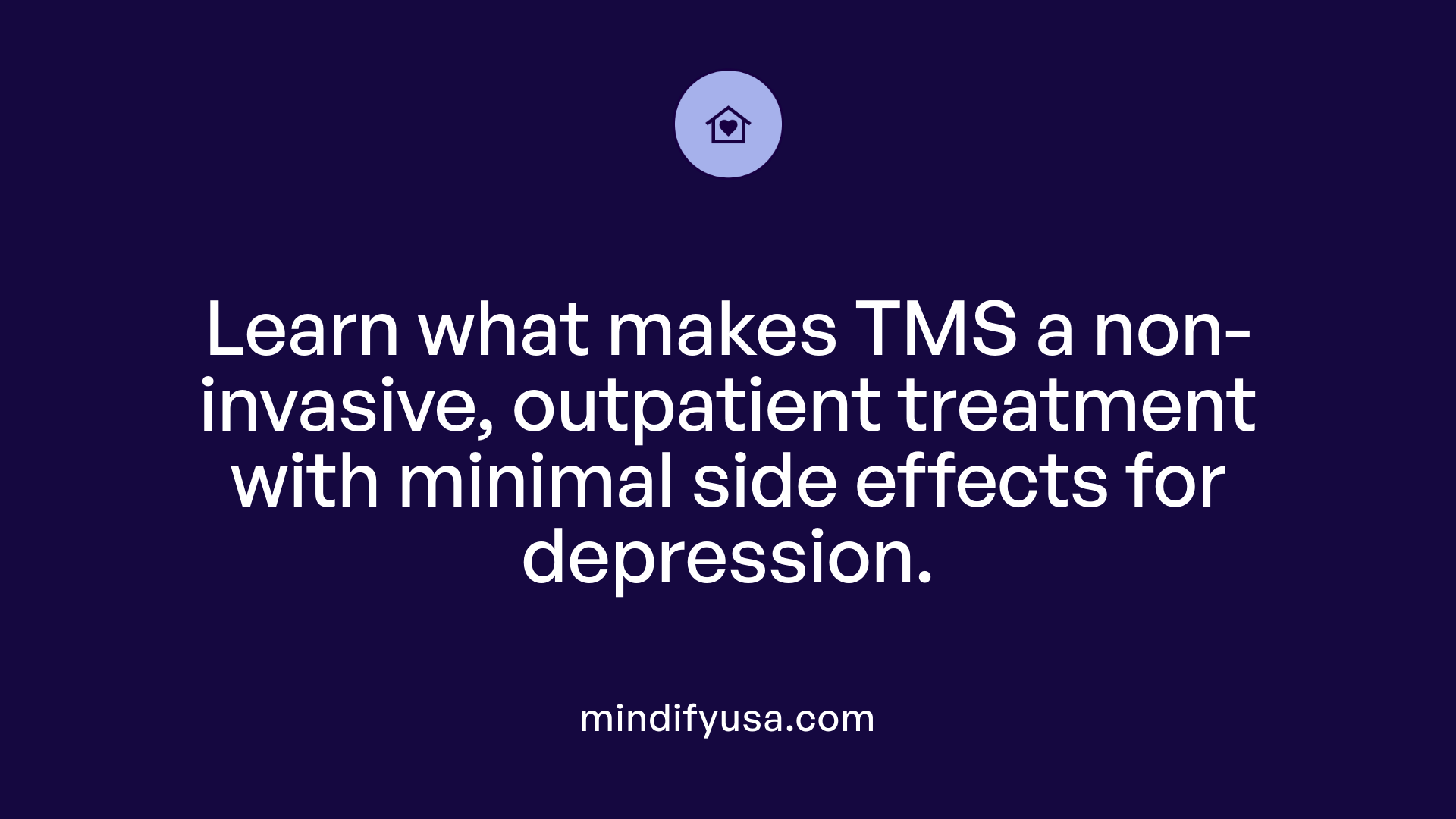
What does TMS therapy involve, and how does it differ from other brain stimulation treatments?
Transcranial Magnetic Stimulation (TMS) is a non-invasive procedure that uses magnetic fields to activate nerve cells in specific parts of the brain linked to mood regulation. During a TMS session, a healthcare provider places a magnetic coil against the patient’s scalp, usually over the prefrontal cortex. This coil emits short bursts of magnetic pulses that stimulate neurons, helping to improve symptoms of conditions like depression.
The process is straightforward and does not require surgery, anesthesia, or injections. Treatments typically take between 20 to 45 minutes and are performed in an outpatient setting, meaning patients can go home immediately afterward. Many patients experience only mild sensations, such as a tapping or clicking sound on the scalp, which generally diminishes after initial sessions.
TMS differs from electroconvulsive therapy (ECT), an invasive treatment that involves passing electrical currents through the brain to induce controlled seizures. ECT requires anesthesia and can cause side effects such as short-term memory loss. In contrast, TMS does not cause seizures or require sedation, making it safer and more tolerable.
Furthermore, TMS is different from implant-based brain stimulation methods like vagus nerve stimulation (VNS) or deep brain stimulation (DBS), which involve surgical implantation of devices into the brain or nervous system. These procedures carry higher risks and are generally reserved for severe cases.
An advanced form known as Deep TMS uses specialized H-coils that reach deeper brain regions, broadening the scope of possible treatments. This method is useful for treating depression, obsessive-compulsive disorder (OCD), and for smoking cessation.
In summary, TMS offers a precise, safe, and minimally invasive alternative to traditional and invasive brain stimulation procedures. Its efficacy, coupled with its outpatient nature and minimal side effects, has made it a popular choice for patients resistant to medications or seeking non-pharmacological options.
Debunking Myths: Is TMS Safe and Effective?
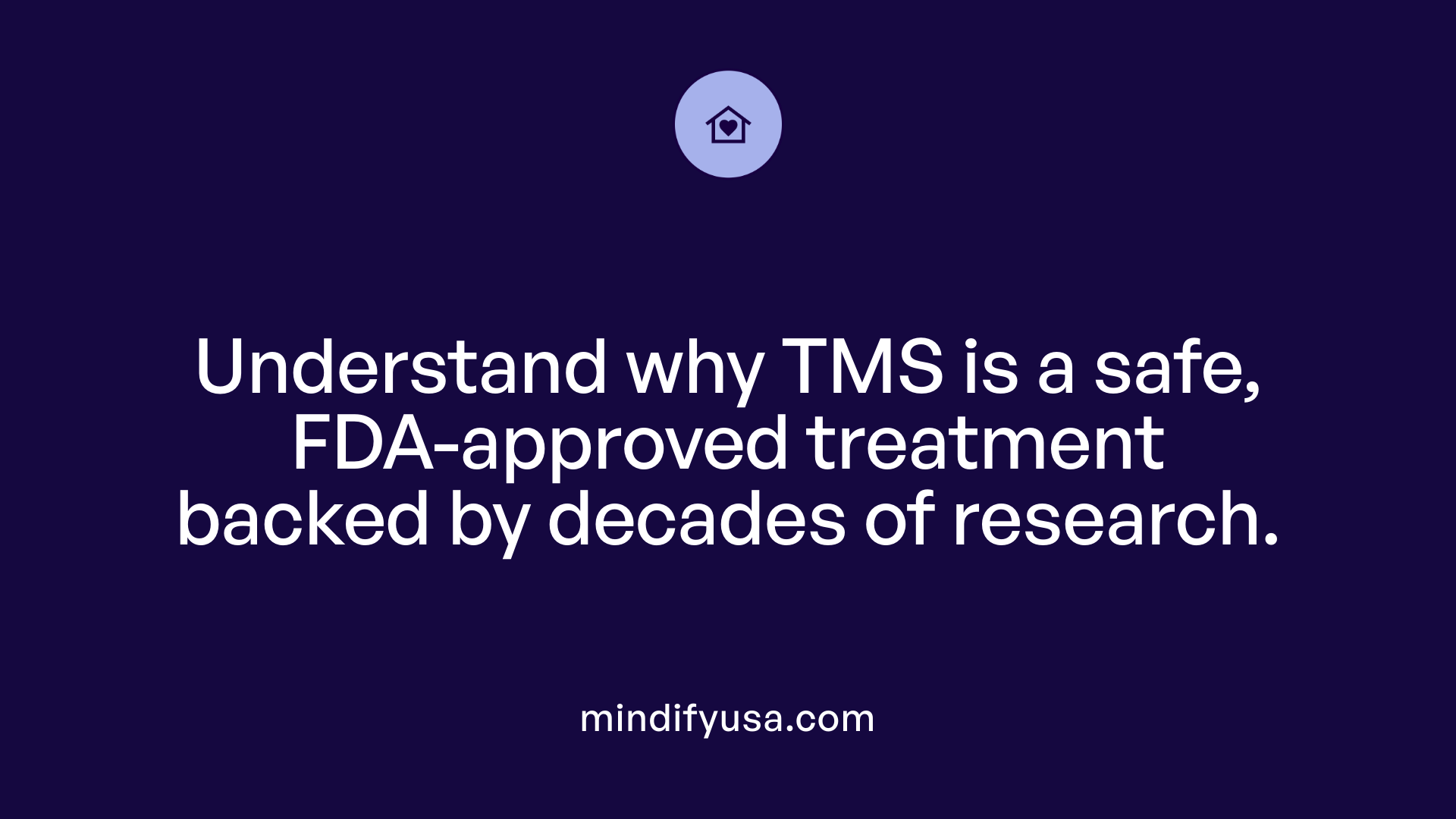
What is the FDA’s stance on TMS and what does extensive research say?
Transcranial Magnetic Stimulation (TMS) has been approved by the U.S. Food and Drug Administration (FDA) since 2008 for the treatment of major depressive disorder, especially in cases where medications have failed to provide relief. Its approval was based on robust evidence from numerous clinical trials showing that TMS can significantly improve depressive symptoms. Research over the past several decades, including large-scale, double-blind studies, consistently supports TMS’s efficacy. For example, many patients experience marked reductions in depression severity after completing a course of TMS, with response rates frequently reported around 60-75%. Studies have also extended its approved uses beyond depression, including conditions like OCD and migraines, further demonstrating its versatility. While some analyses note variability in individual responses, the broad scientific consensus affirms that TMS is a well-supported, evidence-based treatment option for mental health conditions.
How effective is TMS in treating depression, especially resistant cases?
TMS treatment boasts impressive success rates, particularly in difficult cases of depression that do not respond to medications—a situation known as treatment-resistant depression. Most treatments consist of daily sessions over 4 to 6 weeks, each lasting about 20 to 40 minutes. Clinical data show that approximately 85% of patients see some improvement, and about 46% experience remission—meaning their symptoms are significantly reduced or resolved. This high likelihood of response makes TMS a valuable alternative for patients who cannot tolerate antidepressant side effects or have not gained relief through conventional therapy. In addition, studies indicate that results can last six months or longer, especially when combined with maintenance sessions, due to the neuroplasticity promoted by magnetic stimulation.
What are the common and rare side effects, and how safe is TMS?
TMS is widely regarded as a safe procedure with a low risk of serious side effects. Most patients report mild sensations during treatment, such as a tapping or clicking on the scalp, which are not painful. The most common temporary side effects include scalp discomfort, mild headaches, or lightheadedness. These symptoms usually resolve quickly and can often be managed with over-the-counter pain relievers or adjustments to treatment intensity. Serious adverse events, such as seizures, are exceedingly rare, occurring in less than 0.1% of cases when safety protocols are followed diligently. TMS does not involve anesthesia, surgery, or electrical currents passing through the body, further underscoring its safety profile. In comparison to electroconvulsive therapy (ECT), TMS is non-invasive, does not cause memory loss or cognitive decline, and bears fewer risks overall.
What is known about the long-term benefits and how long their effects last?
Many patients experience sustained relief from depression symptoms for months or even over a year after completing TMS treatments. This longevity is believed to be related to the neuroplastic effects—brain changes induced by magnetic stimulation—that promote lasting improvements. Ongoing maintenance sessions or booster treatments can help prolong the benefits further, making TMS not just a quick fix but a potentially long-term solution. Research continues to explore how to optimize these long-term effects, with some models suggesting that repeated courses or ongoing periodic treatments might be most effective.
| Aspect | Details | Additional Notes |
|---|---|---|
| FDA approvals | Since 2008 for depression, also for migraines and OCD | Supported by extensive research |
| Response rate | 60-75% in depression, higher in resistant cases | Significant in treatment-resistant populations |
| Remission rate | Approximately 46% | Can last six months or more |
| Side effects | Mild headaches, scalp discomfort, rare seizures | Serious side effects are exceedingly rare |
| Session duration | About 20-45 minutes per session | Daily treatments over 4-6 weeks |
| Long-term impact | Benefits can last 6 months to over a year | Maintenance can extend effect duration |
| Safety profile | Excellent, minimal side effects | No brain damage or memory issues |
Overall, TMS stands as a safe, effective, and well-supported treatment for depression, especially suited for individuals seeking alternatives to medication or who have not found relief through traditional therapies.
Addressing the Myths on Pain and Risks
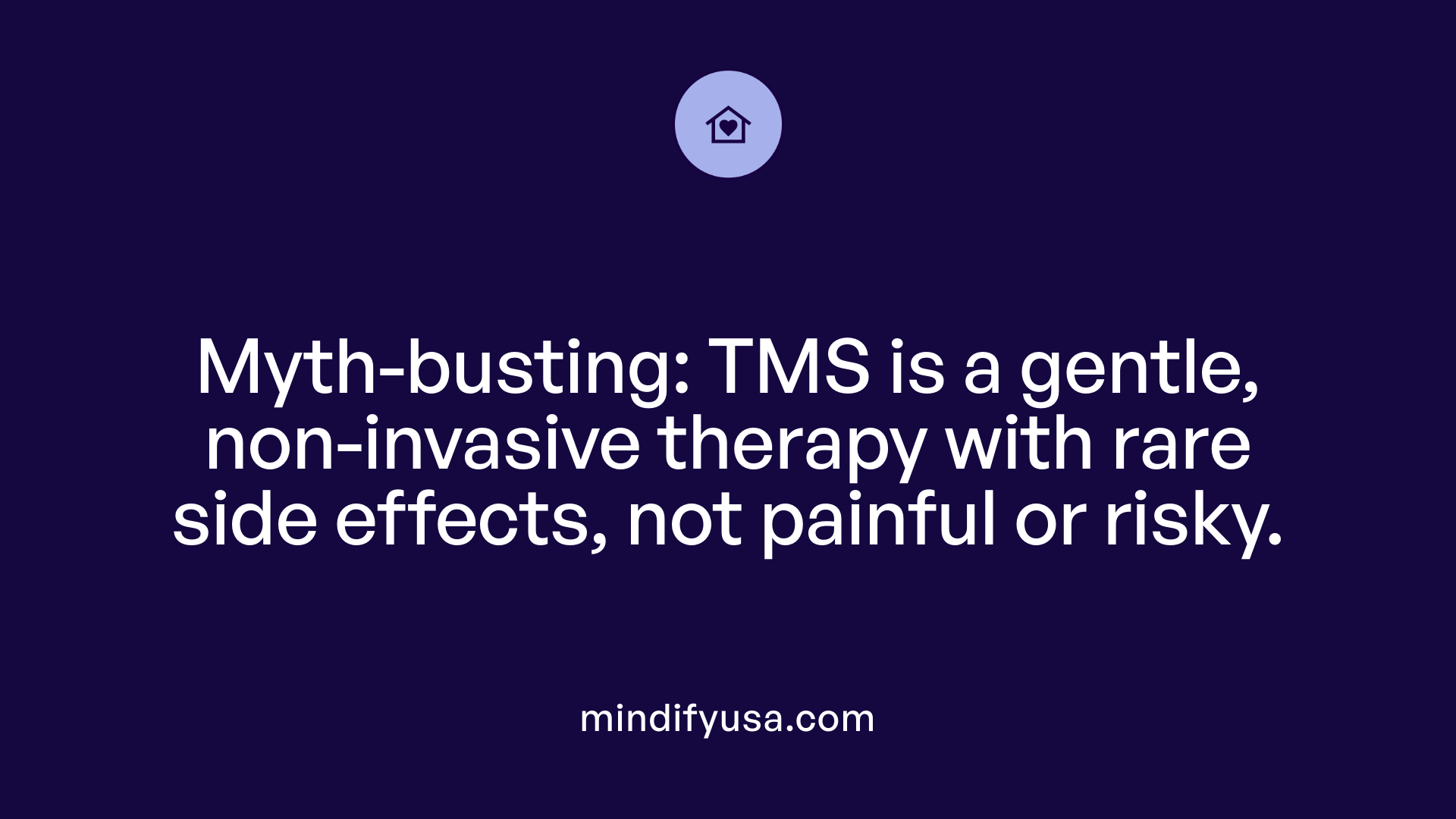
What are some common myths and misconceptions about TMS therapy?
Many people harbor false beliefs about Transcranial Magnetic Stimulation (TMS), often imagining it as a painful or risky procedure. In reality, TMS is a non-invasive treatment that is gentle, safe, and well-tolerated by most patients. The treatment involves placing a magnetic coil lightly on the scalp, which emits electromagnetic pulses to stimulate targeted brain regions. Patients typically experience only mild sensations, such as tapping, clicking, or tingling, which many find tolerable and not painful.
A prevalent misconception is that TMS might cause severe side effects like brain damage or long-term cognitive impairments. However, there is no clinical evidence supporting these fears. TMS uses magnetic energy similar to that in MRI machines, and it does not involve electrical currents passing directly through the brain tissue. Serious adverse effects are exceedingly rare, with seizures occurring in less than 0.1% of cases, especially when safety guidelines are followed.
Some believe TMS is unproven or experimental, but it has been in use for over three decades and received FDA approval in 2008 for treatment-resistant depression. The treatment is backed by extensive research and is endorsed by major psychiatric organizations. It is not only effective for depression but has also been approved for other conditions like OCD and migraines.
Furthermore, many think TMS necessitates hospitalization or anesthesia, which is false. The procedure is outpatient, typically lasting about 20 to 45 minutes per session, with no need for sedation. Patients remain awake and alert, able to resume daily activities immediately afterward. This organization of sessions over several weeks often results in sustained symptom relief, with benefits lasting six months or longer.
Age or physical health does not exclude the use of TMS, making it a suitable option for the elderly, pregnant women, and those who cannot tolerate medications. Insurance coverage for TMS is expanding as its efficacy becomes more widely recognized, further increasing accessibility.
In summary, dispelling myths about TMS reveals that it is a safe, effective, and convenient treatment for various mental health conditions. Its minimal discomfort, rare side effects, and non-invasive nature make it an appealing alternative or complement to traditional therapies.
Expanding on TMS Applications and Benefits
How can TMS therapy be used safely and effectively in treating depression?
Transcranial Magnetic Stimulation (TMS) has established itself as a safe and effective option for treating major depression, especially in cases where traditional treatments like medication and psychotherapy fall short. As an FDA-approved, non-invasive procedure, TMS uses magnetic fields to stimulate targeted areas of the brain involved in mood regulation, notably the dorsolateral prefrontal cortex.
The process involves placing a coil on the patient’s scalp, which emits electromagnetic pulses to activate neurons without the need for anesthesia or sedation. Patients remain awake and alert during sessions, which typically last around 20 to 40 minutes. Most treatments are administered daily over a period of 4 to 6 weeks, with some clinics offering accelerated protocols to shorten the overall treatment course.
Safety is a central advantage of TMS. The most common side effects are mild, including scalp discomfort, headaches, or muscle twitching, usually subsiding after initial sessions. Serious side effects like seizures are exceedingly rare, occurring in less than 0.1% of cases when safety guidelines are followed. This high safety profile makes TMS a suitable choice for various populations, including pregnant women, the elderly, and those intolerant to medications.
Research consistently demonstrates substantial efficacy for treatment-resistant depression. Response rates can reach up to 70%, with nearly half of patients experiencing remission. Notably, the benefits of TMS often last for several months or even over a year, especially with maintenance sessions tailored to individual needs.
Broadening treatment beyond depression, including anxiety, OCD, PTSD
While originally approved for depression, TMS’s scope has expanded due to promising research and clinical trials. It is now considered a beneficial treatment for several other mental health conditions, including anxiety disorders, obsessive-compulsive disorder (OCD), and post-traumatic stress disorder (PTSD). Studies have shown that stimulating specific brain regions can alleviate symptoms associated with these conditions, and some experimental protocols are exploring TMS’s role in treating chronic pain, substance use disorders, and certain neurological conditions.
For instance, in OCD, stimulating the orbitofrontal cortex has resulted in significant symptom reduction in controlled trials. PTSD patients have also reported improvement when TMS targets the prefrontal cortex, helping restore balance in emotional regulation circuits. These expanding applications are supported by ongoing research and clinical trials that validate TMS’s versatility and safety.
Duration and durability of treatment effects
One of TMS’s strengths is the potential for long-lasting benefits. Many studies have shown that symptom relief can extend beyond the immediate post-treatment period, with effects lasting from six months up to a year or more. This durability is attributed to neuroplasticity—the brain’s ability to reorganize itself in response to stimulation.
Maintenance procedures involving periodic sessions can help sustain these benefits, especially in chronic or recurrent conditions. Patients often experience continued improvements in mood, energy, concentration, and overall well-being, making TMS a particularly attractive option for those seeking lasting relief without ongoing medication dependence.
Advantages over traditional medication and invasive procedures
Compared to pharmacological treatments, TMS offers several notable advantages. Since it is non-invasive, there’s no need for needles, surgery, or anesthesia, and patients can return home immediately after sessions. The procedure is painless, with only mild sensations like tapping or clicking sounds during stimulation.
Unlike electroconvulsive therapy (ECT), which requires anesthesia and can cause significant cognitive side effects, TMS does not induce seizures or memory loss. Its safety profile and minimal side effects make it suitable for a broad range of patients, including those who are medication intolerant or prefer a non-drug approach.
Furthermore, TMS’s quick outpatient sessions fit seamlessly into daily routines, with minimal disruption. As insurance coverage expands and more research confirms its efficacy, TMS stands out as a modern, patient-friendly alternative or adjunct to traditional treatments, providing hope for individuals with conditions resistant to medication and psychotherapy.
| Application Area | Typical Protocol | Evidence of Effectiveness | Additional Notes |
|---|---|---|---|
| Major Depressive Disorder | 20-40 min/day for 4-6 weeks | Up to 70% response rate; remission in 46% | Safe, well-tolerated, long-lasting effects |
| Anxiety Disorders | Varying protocols | Promising results in trials | More research needed |
| OCD | Targeted stimulation of orbitofrontal cortex | Significant symptom reduction | FDA approval for OCD |
| PTSD | Prefrontal cortex stimulation | Some improvement in symptoms | Under ongoing study |
| Chronic Pain | Specific brain areas | Emerging evidence | Not yet standard practice |
This table summarizes the main applications of TMS, typical protocols, effectiveness evidence, and noteworthy points for each condition.
Moving Forward with Confidence in TMS
As research advances and clinical experience grows, TMS therapy continues to prove itself as a safe, effective, and patient-friendly treatment for depression and other mental health conditions. Correcting misconceptions and understanding the facts about TMS can help dispel fears, increase acceptance, and provide more individuals with access to a promising alternative that can significantly improve quality of life. Education and ongoing research are essential to fully realizing the potential of this innovative therapy, ensuring it remains a cornerstone of non-invasive brain stimulation treatments.
References
- It's Not Brain Zapping: Let's Debunk These 8 TMS Therapy ...
- Myth vs. Reality about TMS Therapy
- Common Myths About TMS Therapy Debunked
- Debunking Myths About TMS Treatment
- Top 12 Myths about TMS Therapy Debunked
- Your Guide to Debunking 7 Myths About Brain Stimulation ...
- Addressing Misconceptions About TMS Therapy
- Is TMS Therapy Painful? Debunking Myths and Common ...
- Debunking Five Myths About TMS











